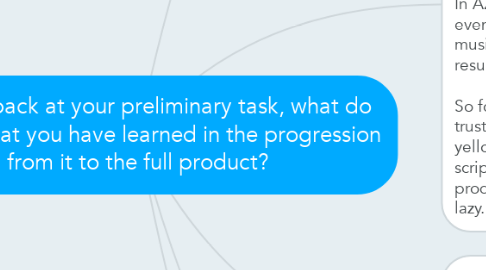Looking back at your preliminary task, what do you feel that you have learned in the progression from it to the full product?
by charlotte march

1. In AS I tended to leave planning to the others in my group and go with the flow, whereas A2 was my first solo video; which mean that I panicked a lot about coming up with something interesting as opposed to good. There was no fixed storyboard in place of the music video and apart set design (painting shed interior, black squares for puppet background) and other mise en scene details (painting masks, bringing in props hiring out photoshoot room(s) at school, I really had lost the plot. I felt as though I learned from my mistakes in the AS redo: I created a fixed storyboard, a script, hired out locations (The Pit & Pendulum) further away from home and school, procured more lighting after the fiasco of the first shoot - and actually did follow through with re-filming.
2. I've learned that casting can be just as important as the project itself. Although we are not graded on our actor's abilities, I felt that it made the editing project less of a chore whilst trawling for clips that don't sound like they're soundbyted from a primary school nativity. Such is seen in my first AS project where relatives of a member of our group (husband, wife and child) agreed to star. Tom's - the radio host's - performance was sort of okay, but he kept forgetting his lines and mispronouncing words in the script. In A2, I decided to cast puppets instead of actors, but they eventually drifted into the picture, face covered by masks). As the music video was abstract, it required no acting on their half, but resulted in a very weird, and hard to follow music video. So for the AS redo, I made a conscious decision to hire good actors who I could trust: enter Summer Keeling, who also starred in my A2 music video with the yellow mask. Lisa, had "the look of a criminal" so I approached her with the script; originally I was to be the corpse on the floor but I learned during this product that I cannot act, and it is more important to make something good, then lazy.
3. In regards to the more audible area of my film opening, I became more interested in foley and how to add it onto that of low quality; obtained through filming with the canon 100d (designed more for photography than film so a lot of background noise and a continual hum could be heard). The phone vibrating phone was created with a microphone held close to my own phone, and the phone going dead was sourced from youtube. Additional sounds (non-diegetic music in the background and tense noises) was obtained with the help of Soundcloud. This taught me that I shouldn't be afraid to improvise. If additional sound had to be included, then it had to be added; regardless of the plan/storyboard. However, I also learned that there was only so much you could do in the editing progress; If you collect dodgy sound on the day of filming (e.g. dialog) then it'll show no matter how much additional editing is added.
4. With Premier Pro, I also learnt a lot about cuts - and the additional effects that it can have on the overall meaning of a film/music video. Fades and wipes offered a more natural transition than if compared to quick, clean cuts which I used a lot in key with the genre of Thriller. This is due to the fact that I wanted the action to be fast paced in order to build up as much tension as possible in so short an amount of time.
5. I had also learned that through parallel editing, multiple meanings could be conveyed as two stories going on at the same time was more likely to keep the attention of the viewer as opposed to just, say, the running through the street or shots of an individual cleaning up a body on their own.


